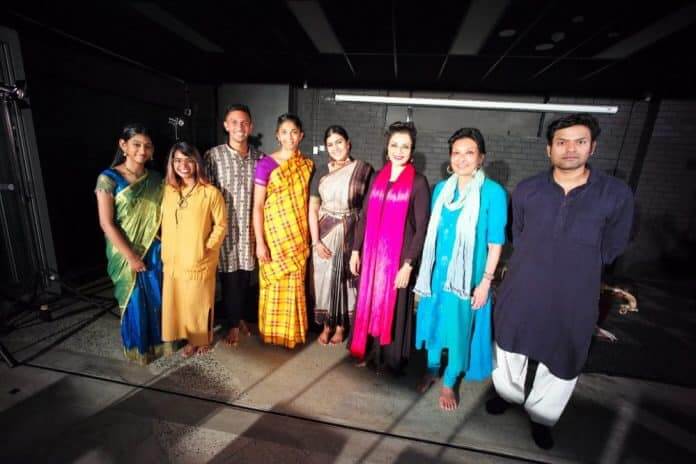
What better occasion to reimagine dance, than Shivarathri.
It was Swarnamalya, multifacted entertainment personality and invited speaker at the event Reimagining Dance: Brown Bodies on the Global Stage, who made this connection to everyone’s delight.
“Being the auspicious occasion of Shivarathri today, dancers all around the world are celebrating the cosmic dancer Lord Nataraja,” she told the audience. “I would like to begin this evening by celebrating the common dancer that resides in all of us.”

It was a perfect prelude to an evening of performance and conversation at which two other luminaries joined the fabulous Swarnamalya: Mallika Sarabhai, one of India’s all-time favourite classical dancers; and Anita Ratnam, a classical and contemporary dancer, arts entrepreneur and culture mentor. Together the trio placed their ancient art in the modern contextand reaffirmed its place and relevance in the world today.
In her presentation, Swarnamalya, as a practitioner of ‘sadir’, a name by which Bharathanatyam was known in earlier times, focussed on the fluid nature of art: India is a melting pot of cultures, she indicated, and it is this diversity that gives it strength and variety. The Mughal rulers who played an important part in the history of India, were great patrons of art and there was a generous sharing of cultures during that era. Swarnamalya bemoaned the loss of such tolerance in today’s society. This she encapsulated through a shabdam by Raja Serfoji weaving in the Mughal greeting – the salaam – into a traditional piece of the Bharathanatyam repertoire. It was immediately refreshing: loyal to the traditional format of the shabdam, it conveyed beautifully the essence of tolerance and of amalgamation of different cultures.

Mallika, steeped in dance from a very young age being the daughter of the illustrious Mrinalini Sarabhai, essayed the need to be inclusive of the modern way of life when presenting one’s art. “We must move with the times,” she offered, “and accept that love is universal, without barring caste, creed, social status and gender.” Through a padam that she had penned, she asked several questions on social norms and a society that is always judgemental, categorising certain relationships as abnormal. Taking the form of a conversation with Lord Krishna, the padam questions as to “why we are criticised for our choices in love when your love for Radha, a maiden several years older than you, stands the test of time and is celebrated and considered eternal.”
Fingers clicking, feet tapping, vocalising sollukattus (verbal percussion) Anita Ratnam stepped on to the performing space transforming it and transporting the audience with her to a world of imagination. Evil or good is only a matter of perspective. This was beautifully encapsulated in Anita Ratnam’s piece presenting the character of Soorpanakha from the Ramayana. Reimagining the stereotypical image of Soorpanakha as a demoness, ugly and gross, oozing evil, Ratnam created a vision of a brown, brave, bold and beautiful seductress who was clever enough to know what she wanted and determined enough to have a go. Not only did Anita Ratnam reimagine Soorpanakha, but had our imaginations running wild with the way she used body language, space and a startlingly red fabric as an accessory that weaved magic.

Earlier on, the vibrations of one of the oldest Indian instruments, the veena, set a wonderful backdrop for the performances. Played by Kasthuri Sahathevan from Melbourne, the veena accompanied the visionary verses of the Tamil poet Bharathiyar, sung by Arjunan Puveendran.
The conversation that followed the presentations moderated by Indu Balachandran touched upon several burning issues facing the classical arts today. Is that what is deemed traditional, really so? Is dance to be used as a medium of communicating one’s thoughts, or is dance today elitist, talking of a time gone by and catering to a chosen few. Are the people who pull the strings of the purse, the organisers of festivals and performances, truly aware of the value of what is being showcased as Indian art? The struggles of a diaspora that cling to tradition through a desperate attempt to immerse themselves in the classical arts, the one-click generation that want everything easy trying to learn dance piecemeal and lacking a holistic approach to the artform, were some of the other challenges discussed.
When asked about how to strike a balance and negotiate an acceptance of contemporary interpretations of the traditional, all three artists were convinced that when art is reimagined, it is always loosely labelled and grouped as “the other”. It requires a lot of conviction from the artist to make it mainstream and for it to be accepted and validated as authentic by the audience.
In this, Swarnamalya Ganesh, Mallika Sarabhai and Anita Ratnam certainly have carved a niche for themselves on the global stage and in the minds and hearts of their audiences, through extensive research, a deep understanding and an innate love for their artform.
A question that one pondered was that, to reimagine, one needs to firstly have a firm grounding in and understanding of traditional practice. For this there is a need for dance institutions that teach the art – their value cannot be underestimated.
Secondly, can reimagining be taught, or is it an intuitive process?
Sponsored by ICE (Information Culture Exchange), KREA University and Australia Council for the Arts, curated by Indu Balachandran and Arjunan Puveendran, the evening was thought provoking, erudite and inspiring to say the least.





